
Italian irredentism in Dalmatia was the political movement supporting the unification to Italy, during the 19th and 20th centuries, of Adriatic Dalmatia.

Italian irredentism in Dalmatia was the political movement supporting the unification to Italy, during the 19th and 20th centuries, of Adriatic Dalmatia.
The Republic of Venice, between the 9th century and 1797, extended its dominion to Istria, the islands of Kvarner and Dalmatia, when it was conquered by Napoleon. [1] After the fall of Napoleon (1814) Istria, the islands of Kvarner and Dalmatia were annexed to the Austrian Empire. [2] From the Middle Ages to the 19th century, Italian and Slavic communities in Istria and Dalmatia had lived peacefully side by side because they did not know the national identification, given that they generically defined themselves as "Istrians" and "Dalmatians", of "Romance" or "Slavic" culture. [3] Later, many Istrian Italians and Dalmatian Italians looked with sympathy towards the Risorgimento movement that fought for the unification of Italy. [4] The first events that involved the Dalmatian Italians in the unification of Italy were the revolutions of 1848, during which they took part in the constitution of the Republic of San Marco in Venice. The most notable Dalmatian Italians exponents who intervened were Niccolò Tommaseo and Federico Seismit-Doda. [5]

After the Third Italian War of Independence (1866), when the Veneto and Friuli regions were ceded by the Austrians to the newly formed Kingdom Italy, Istria and Dalmatia remained part of the Austro-Hungarian Empire, together with other Italian-speaking areas on the eastern Adriatic. This triggered the gradual rise of Italian irredentism among many Italians in Istria, Kvarner and Dalmatia, who demanded the unification of the Julian March, Kvarner and Dalmatia with Italy. The Italians in Istria, Kvarner and Dalmatia supported the Italian Risorgimento; as a consequence, the Austrians saw the Italians as enemies and favored the Slav communities of Istria, Kvarner and Dalmatia, [6] fostering the nascent nationalism of Slovenes and Croats. [7] During the meeting of the Council of Ministers on 12 November 1866, Emperor Franz Joseph I of Austria outlined a wide-ranging project aimed at the Germanization or Slavization of the areas of the empire with an Italian presence: [8]
His Majesty expressed the precise order that action be taken decisively against the influence of the Italian elements still present in some regions of the Crown and, appropriately occupying the posts of public, judicial, masters employees as well as with the influence of the press, work in South Tyrol, Dalmatia and Littoral for the Germanization and Slavization of these territories according to the circumstances, with energy and without any regard. His Majesty calls the central offices to the strong duty to proceed in this way to what has been established.
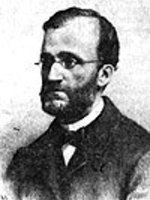
The Italian linguist Matteo Bartoli calculated that Italian was the primary spoken language of 33% of the Dalmatian population in 1803. [10] [11] Bartoli's evaluation was followed by other claims that Auguste de Marmont, the French Governor General of the Napoleonic Illyrian Provinces commissioned a census in 1809 which found that Dalmatian Italians comprised 29% of the total population of Dalmatia. In Dalmatia there was a constant decline in the Italian population, in a context of repression that also took on violent connotations. [12] During this period, Austrians carried out an aggressive anti-Italian policy through a forced Slavization of Dalmatia. [13]
With the development of Croatian nationalism, critics such as Croatian historian Duško Večerina alleged that these evaluations were not conducted by modern scientific standards and that they took spoken language as the criterion, rather than blood, origin and ethnicity. They pointed out that according to a report by Imperial court councillor Joseph Fölch in 1827, the Italian language was spoken by noblemen and some citizens of middle and lower classes exclusively in the coastal cities of Zadar, Šibenik and Split. Since only around 20,000 people populated these towns and not all were Italian speakers, they claim that the real number was rather smaller, probably around seven percent of the total population, as is asserted by the Department of Historical Studies of the Croatian Academy of Sciences and Arts (HAZU). [14]

Italian irredentists like Gabriele D'Annunzio, as well as prominent Italian scholars like Angelo Vivante, alleged that Fölch did not include the Dalmatian islands of Cres (Cherso), Lošinj (Lussino), Krk (Veglia), Vis (Lissa), Hvar (Lesina), Korcula (Curzola) and many other islands with significant Italian communities. They reasserted that the only official evidence about the Dalmatian population comes from the 1857 Austro-Hungarian census, which showed that in this year there were 369,310 indigenous Croatians and 45,000 Italians in Dalmatia, [15] making Dalmatian Italians 10.8 percent of the total population of Dalmatia in the mid-19th century.
Two nationalist movements were born in Dalmatia, the Italian and the Slav. The political instances of the Dalmatian Italians were promoted to the Autonomist Party, founded in 1878 and dissolved in 1915: a prominent member was Antonio Bajamonti, who from 1860 to 1880 was mayor of Split. [5] The party, which originally also had the favour of part of the Slavic population, gradually replaced an autonomous program for the region with an irredentist project for the region, given the hostility of the Austrian authorities and the disagreements with the Slavic element. [16] [17]
In 1889, the foundation of the Dante Alighieri Society, with the aim of protecting and promoting the Italian language, made it possible to give support to the initiatives for the preservation of the Italian-speaking linguistic element. In this period Roberto Ghiglianovich, as trustee of the company establishes the La Lega in Zadar and promoted the enhancement of Italian culture in the area. [18] The same year the irredentist Luigi Ziliotto becomes mayor of Zara, a position he would hold until the outbreak of World War I, was accused of treason and declared forfeited by the Austrian authorities. [19] The policy of collaboration with the local Serbs, inaugurated by Roberto Ghiglianovich and by Giovanni Avoscani, then allowed the Italians to conquer the municipal administration of Dubrovnik in 1899. [20]
The Italian population in Dalmatia was concentrated in the major coastal cities. In the city of Split in 1890 there were 1,969 Dalmatian Italians (12.5% of the population), in Zadar 7,423 (64.6%), in Šibenik 1,018 (14.5%), in Kotor 623 (18.7%) and in Dubrovnik 331 (4.6%). [21] In other Dalmatian localities, according to Austrian censuses, Dalmatian Italians experienced a sudden decrease: in the twenty years 1890-1910, in Rab they went from 225 to 151, in Vis from 352 to 92, in Pag from 787 to 23, completely disappearing in almost all the inland locations.
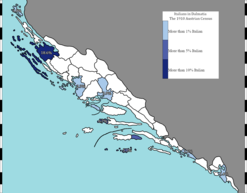

In 1909, the Italian language lost its status as the official language of Dalmatia in favour of Croatian only (previously both languages were recognized), thus Italian could no longer be used in the public and administrative sphere. [22]
For the Austrian Kingdom of Dalmatia, (Dalmatia), the 1910 numbers were 96.2 percent Slavic speakers and 2.8 percent Italian speakers, [23] recording a drastic decline in the number of Dalmatian Italians, who in 1845 amounted to 20 percent of the total population of Dalmatia. [24] Another evidence about the Dalmatian population comes from the 1857 Austro-Hungarian census, which showed that in this year there were 369,310 indigenous Croatians and 45,000 Italians in Dalmatia, [25] making Dalmatian Italians 10.8 percent of the total population of Dalmatia in the mid-19th century.
Dalmatia was a strategic region during World War I that both Italy and Serbia intended to seize from Austria-Hungary. Italy joined the Triple Entente Allies in 1915 upon agreeing to the London Pact that guaranteed Italy the right to annex a large portion of Dalmatia in exchange for Italy's participation on the Allied side. From 5–6 November 1918, Italian forces were reported to have reached Vis, Lastovo, Šibenik, and other localities on the Dalmatian coast. [26] By the end of the hostilities in November 1918, the Italian military had seized control of the entire portion of Dalmatia that had been guaranteed to Italy by the London Pact and by 17 November had seized Fiume as well. [27] In 1918, Admiral Enrico Millo declared himself Italy's Governor of Dalmatia. [27] Italian nationalist Gabriele d'Annunzio supported the seizure of Dalmatia, and proceeded to occupy some areas in an Italian warship in December 1918. [28]
The last city with a significant Italian presence in Dalmatia was the city of Zara (now called Zadar). In the Austro-Hungarian census of 1910, the city of Zara had an Italian population of 9,318 out of 13,438 inhabitants (69.3 percent). [29] In 1921, the population grew to 17,075 inhabitants, of which 12,075 Italians (70.8 percent). [30] In 1941, during World War II, Yugoslavia was occupied by Italy and Germany. Dalmatia was divided between Italy, which constituted the Governorate of Dalmatia, and the Independent State of Croatia, which annexed Dubrovnik and Morlachia. After the Italian surrender on 8 September 1943, the Independent State of Croatia annexed the Governorate of Dalmatia, except for the territories that had been Italian before the start of the conflict, such as Zara.
In 1943, Josip Broz Tito informed the Allies that Zara was a chief logistic centre for German forces in Yugoslavia. By overstating its importance, he persuaded them of its military significance. Italy surrendered in September 1943 and over the following year, specifically between 2 November 1943 and 31 October 1944, Allied Forces bombarded the town 54 times. Nearly 2,000 people were buried beneath rubble; 10–12,000 people escaped and took refuge in Trieste and just over 1,000 people reached Apulia. Tito's partisans entered the city on 31 October 1944, and 138 people were killed. [31]
With the Peace Treaty of 1947, Dalmatian Italians still living in Zadar and in Dalmatia followed the Italian exodus from Istria and Dalmatia and only about 500 Dalmatian Italians now remain in Dalmatia. In particular, according to the official Croatian census of 2011, there are 83 Dalmatian Italians in Split (equal to 0.05% of the total population), 16 in Šibenik (0.03%) and 27 in Dubrovnik (0.06%). [32] According to the official Croatian census of 2021, there are 63 Dalmatian Italians in Zadar (equal to 0.09% of the total population). [33] According to the official Montenegrin census of 2011, there are 31 Dalmatian Italians in Kotor (equal to 0.14% of the total population). [34]

Dalmatia is one of the four historical regions of Croatia, alongside Central Croatia, Slavonia and Istria, located on the east shore of the Adriatic Sea in Croatia.

Istria is the largest peninsula within the Adriatic Sea. The peninsula is located at the head of the Adriatic between the Gulf of Trieste and the Kvarner Gulf. It is shared by three countries: Croatia, Slovenia, and Italy, with 87% of surface area being part of Croatia. Croatia encapsulates most of the Istrian peninsula within Istria County.

Italian irredentism was a political movement during the late 19th and early 20th centuries in Italy with irredentist goals which promoted the unification of geographic areas in which indigenous peoples were considered to be ethnic Italians. At the beginning, the movement promoted the annexation to Italy of territories where Italians formed the absolute majority of the population, but retained by the Austrian Empire after the Third Italian War of Independence in 1866.
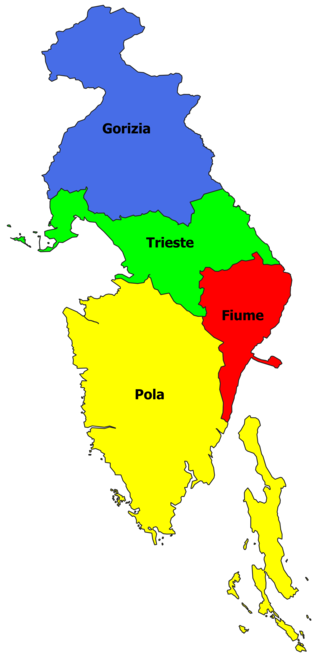
The Julian March, also called Julian Venetia, is an area of southern Central Europe which is currently divided among Croatia, Italy, and Slovenia. The term was coined in 1863 by the Italian linguist Graziadio Isaia Ascoli, a native of the area, to demonstrate that the Austrian Littoral, Veneto, Friuli, and Trentino shared a common Italian linguistic identity. Ascoli emphasized the Augustan partition of Roman Italy at the beginning of the Empire, when Venetia et Histria was Regio X.
The History of Dalmatia concerns the history of the area that covers eastern coast of the Adriatic Sea and its inland regions, from the 2nd century BC up to the present day. The region was populated by Illyrian tribes around 1,000 B.C, including the Delmatae, who formed a kingdom and for whom the province is named. Later it was conquered by Rome, thus becoming the province of Dalmatia, part of the Roman Empire. Dalmatia was ravaged by barbaric tribes in the beginning of the 4th century.

The Istrian–Dalmatian exodus was the post-World War II exodus and departure of local ethnic Italians as well as ethnic Slovenes and Croats from Yugoslavia. The emigrants, who had lived in the now Yugoslav territories of the Julian March, Kvarner and Dalmatia, largely went to Italy, but some joined the Italian diaspora in the Americas, Australia and South Africa. These regions were ethnically mixed, with long-established historic Croatian, Italian, and Slovene communities. After World War I, the Kingdom of Italy annexed Istria, Kvarner, the Julian March and parts of Dalmatia including the city of Zadar. At the end of World War II, under the Allies' Treaty of Peace with Italy, the former Italian territories in Istria, Kvarner, the Julian March and Dalmatia were assigned to now Communist-helmed Federal Yugoslavia, except for the Province of Trieste. The former territories absorbed into Yugoslavia are part of present-day Croatia and Slovenia.
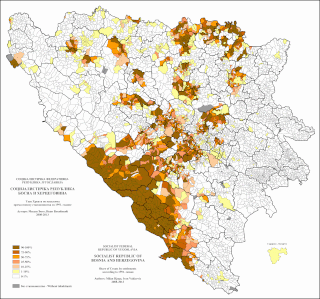
Croatisation or Croatization (Serbo-Croatian: kroatizacija / хрватизација or pohrvaćenje / похрваћење; Italian: croatizzazione; is a process of cultural assimilation, and its consequences, in which people or lands ethnically only partially Croatian or non-Croatian become Croatian.
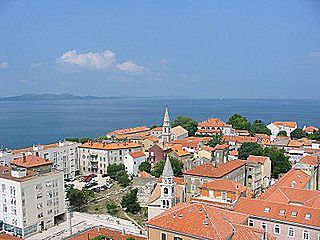
Dalmatian Italians are the historical Italian national minority living in the region of Dalmatia, now part of Croatia and Montenegro.
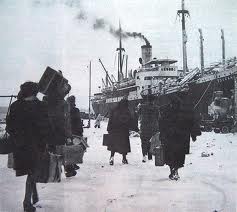
The Italian language is an official minority language in Croatia, with many schools and public announcements published in both languages. Croatia's proximity and cultural connections to Italy have led to a relatively large presence of Italians in Croatia.

The Diet of Dalmatia was the regional assembly of the Kingdom of Dalmatia within the Austro-Hungarian Empire. It was founded in Zadar in 1861 and last convened in 1912, before being formally dissolved in 1918, with the demise of the Empire.

The Governorate of Dalmatia was an administrative division of the Kingdom of Italy, established in 1941, following the military conquest of Yugoslavian Dalmatia by General Vittorio Ambrosio, during World War II. It had the provisional purpose of progressively importing Italian national legislation in Dalmatia in place of the previous one, thus fully integrating it into the Kingdom of Italy.
The Autonomist Party was an Italian-Dalmatianist political party in the Dalmatian political scene, that existed for around 70 years of the 19th century and until World War I. Its goal was to maintain the autonomy of the Kingdom of Dalmatia within the Austro-Hungarian Empire, as opposed to the unification with the Kingdom of Croatia-Slavonia. The Autonomist Party has been accused of secretly having been a pro-Italian movement due to their defense of the rights of ethnic Italians in Dalmatia. The Autonomist Party did not claim to be an Italian movement, and indicated that it sympathized with a sense of heterogeneity amongst Dalmatians in opposition to ethnic nationalism. In the 1861 elections, the Autonomists won twenty-seven seats in Dalmatia, while Dalmatia's Croatian nationalist movement, the National Party, won only fourteen seats. This number rapidly decreased: already in 1870 autonomists lost their majority in the Diet, while in 1908 they won just 6 out of 43 seats.

The foibe massacres, or simply the foibe, refers to mass killings and deportations both during and immediately after World War II, mainly committed by Yugoslav Partisans and OZNA in the then-Italian territories of Julian March, Kvarner and Dalmatia, against local Italians and Slavs, primarily members of fascist and collaborationist forces, and civilians opposed to the new Yugoslav authorities. The term refers to some victims who were thrown alive into the foibe., deep natural sinkholes characteristic of the Karst Region. In a wider or symbolic sense, some authors used the term to apply to all disappearances or killings of Italian and Slavic people in the territories occupied by Yugoslav forces. Others included deaths resulting from the forced deportation of Italians, or those who died while trying to flee from these contested lands.

Istrian Italians are an ethnic group from the Adriatic region of Istria in modern northwestern Croatia and southwestern Slovenia. Istrian Italians descend from the original Latinized population of Roman Histria, from the Venetian-speaking settlers who colonized the region during the time of the Republic of Venice, and from the local Croatian people who culturally assimilated.

Renzo de' Vidovich is a Dalmatian Italian politician, historian and journalist.

In 1918–1920, a series of violent fights took place in the city of Split between Croats and Italians, culminating in a struggle on 11 July 1920 that resulted in the deaths of Captain Tommaso Gulli of the Italian protected cruiser Puglia, Croat civilian Matej Miš, and Italian sailor Aldo Rossi. The incidents were the cause of the destruction in Trieste of the Slovenian Cultural Centre by Italian Fascists.

Italians of Croatia are an autochthonous historical national minority recognized by the Constitution of Croatia. As such, they elect a special representative to the Croatian Parliament. There is the Italian Union of Croatia and Slovenia, which is a Croatian-Slovenian joint organization with its main site in Rijeka, Croatia and its secondary site in Koper, Slovenia.

The Italian irredentism in Istria was the political movement supporting the unification to Italy, during the 19th and 20th centuries, of the peninsula of Istria. It is considered closely related to the Italian irredentism in Trieste and Rijeka (Fiume), two cities bordering the peninsula.

Dalmatian city-states were the Dalmatian localities where the local Romance population survived the Barbarian invasions after the fall of the Western Roman Empire in the 400s CE. Eight little cities were created by indigenous inhabitants who maintained political links with the Eastern Roman Empire which defended these cities, enabling their commercial trade.
Vincenzo Duplancich was a Dalmatian Italian journalist, writer, politician, and nationalist. He promoted Italian culture and the preservation of Italian identity in Dalmatia, firmly opposing the annexation of the latter to Croatia. He was active during and within the Risorgimento.
{{cite book}}: |work= ignored (help)